Tony Wood from the Grattan Institute is one of those lucky people who seems to know everything, and repeatedly sets us all to rights. So when he spoke about the Institute’s new report Keeping the lights on: lessons from South Australia’s power shock (Press Release, where you can download the report) my BS detectors were fully operational. On further investigation, however, the report has value, but there is a twist.
In brief, he points out that we have no climate policy that will reduce emissions in our power system beyond the RET to 2020, and that we need climate change and energy policies that combine to produce reliable, affordable and sustainable clean power.
Secondly, the architecture of the wholesale electricity market and its controlling and monitoring bodies such as the National Electricity Market (NEM) and the Australian Energy Market Operator (AEMO) may have to be redesigned in order to secure the reliable power that Australians take for granted.
Grattan is also saying that moving to clean power will cost us more (I’m not sure about that) and this must be explained.
Wood says the crisis that befell South Australia was not due to bad behaviour, the problem was structural. Wind power was not the culprit, it was poor planning. From Chris Uhlmann:
- The chair of the Australian Energy Regulator, Paula Conboy, said households were insulated from the price hike because electricity retailers hedged short-term prices with long-term contracts.
An investigation showed that there was no evidence of generators not playing by the rules.
“The market worked as expected,” Ms Conboy said.
“The system remains safe and reliable, albeit at higher prices.”
Tony Wood agrees. I remain suspicious. Unfortunately sometimes the ‘authorities’ lie to us.
More important than the early July spike, say Grattan, is that during the month of July the state’s wholesale electricity price averaged $230 per megawatt hour – three and a half times the price in eastern states. And the outlook is for continued higher prices in SA, as reliance on gas increases and the risks perceived from July 2016 are priced into the market, so prospective power-using industries are likely to give the state a swerve. That’s in spite of wind lowering the marginal wholesale prices and leading to fewer spikes. I’ll come back to that.
To take the whole month of July is unfair, as the Heywood interconnector was out for the whole month. Nevertheless, gas and risk are likely to make SA’s future prices high for a time.
The report was written by Tony Wood and David Blowers of the Grattan Institute. Wood has an explanatory piece at The Conversation, republished at RenewEconomy.
Recommended articles are Chris Uhlmann at the ABC and Mark Ludlow at the AFR. I’ll link to some RenewEconomy articles along the way.
RenewEconomy has just reported stunning low prices for solar electricity, with a new world record low of US2.42c/kWh ($A0.032c/kWh) set in a tender for a large solar park in Abu Dhabi, by the biggest manufacturer of solar modules in the world, JinkoSolar.
Moreover:
- it seems, even this bid could be beaten, with the local National newspaper reporting that a local consortium, possibly Masdar Energy, submitting an offer of just US2.3c/kWh if the local authority agrees to write a contract for a solar farm of more than 1.1GW.
It was only 18 months ago that Saudi Arabia-based ACWA Power stunned the solar world, and the broader energy industry, with a bid of less than 6c/kWh in a Abu Dhabi tender.
Giles Parkinson explains that the jaw-dropping solar prices will change energy markets.
The rate of change is accelerating, not slowing, he says. Impressive cost reductions are showing up with wind, both onshore and offshore. Also:
- The cost of solar thermal and storage is also falling, with US company SolarReserve bidding US6.3c-6.5c/kWh in a tender in Chile, which has excellent solar resources. This is less than half the price of the company’s first installation, the 110MW Crescent Dunes facility that is now producing and storing electricity in Nevada.
In response to the Grattan report Bruce Mountain at RenewEconomy asked the question Does rapid renewables expansion necessarily mean higher electricity prices? and produced this impressive table:
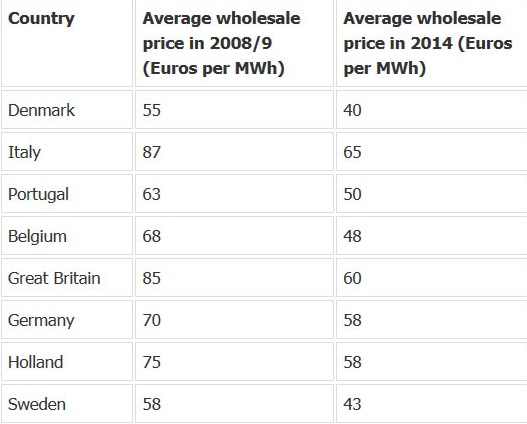
Impressive, and each country will have its own story. If you look at Germany, this was the energy mix in relation to electricity in 2014:
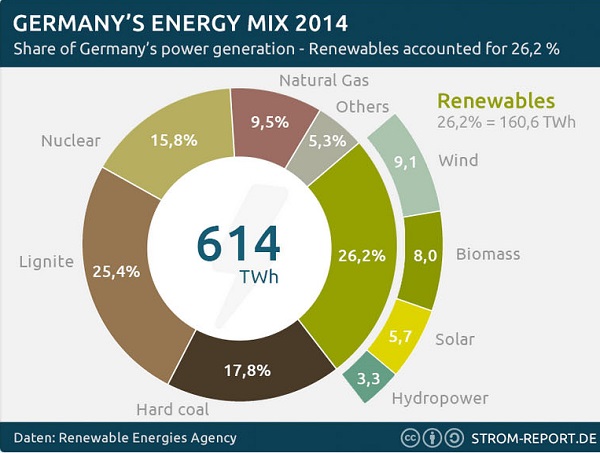
South Australia has a similar, actually larger, penetration of renewables, but here’s their mix, from the Grattan report:
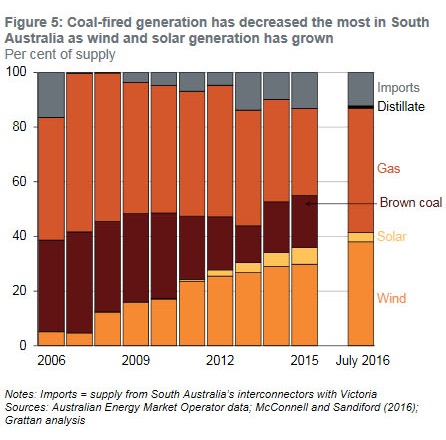
The difference is startling. SA is now almost entirely dependent on wind and gas, with support from Victoria. Germany has some inherent stability in that the wind blows stronger in the winter when the sun doesn’t shine, and they have a significant biomass sector, plus nukes, hard and soft coal, plus a portion of gas, which can be used for quick dispatchable power.
It’s an inherently more stable mix, and is embedded in a larger European system, from which emergency power can be drawn.
This is the record of fossil fuel closure in SA:
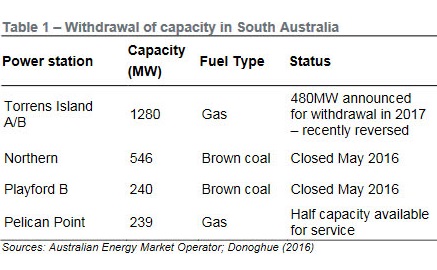
Grattan says that wind has zero or even negative marginal cost, so it has wiped out the spot market to a large extent. The SA Government say this was market failure. Grattan says it’s a case of markets working. Giles Parkinson and others keep saying that fossil fuel operators will need to change their business model. Grattan says they have – coal stations closed because of a lack or profitability, gas operators have found it more profitable to sell gas for export, and in July they were also selling a good deal for heating.
It’s useful at this point to turn to Mike Sandiford, who says We really need to talk about gas.
Gas prices have been reducing in Europe, because they are linked to oil prices. The US has had a flood of shale gas, leading to a domestic glut. In Australia coal seam gas operators wrote export contracts years ago which now have to be honoured. They have had to buy gas from elsewhere in Australia to meet their contracts. Hence we have had scarcity pricing on the domestic market.
Here’s how the price has moved in seasonal segments:
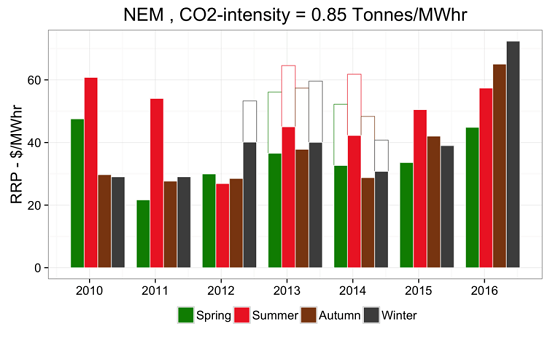
This graph shows the winter prices in SA 115% higher than in the previous winter:
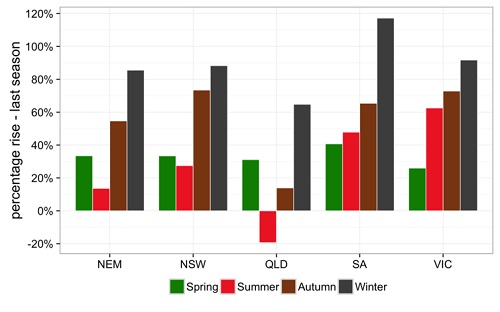
Largely because of gas, Sandiford says, we have in just 18 months gone from having cheaper power than the US and Europe, to having more expensive power, and rapidly converging with Japan, as they restore their nuclear capacity:
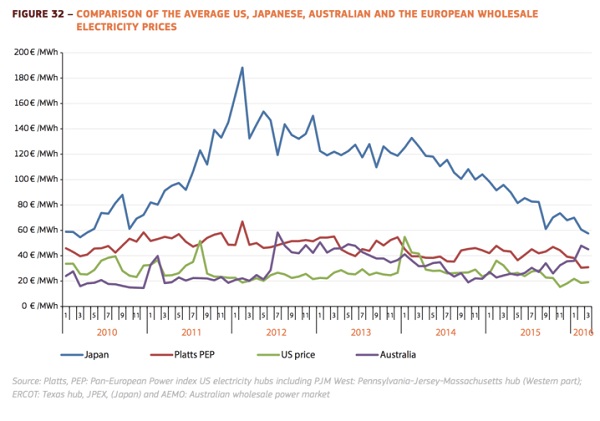
The Grattan report’s bottom line is that a reserve capacity of stanby power is needed to account for occasional peaks to meet any residual problems that might remain as we introduce renewables. They don’t ignore battery storage, or greater network interconnectivity. The report points out that Germany decided as recently as June this year to install:
- a new ‘capacity reserve’. Under this process, the Government would purchase capacity – equivalent to five per cent of maximum demand – that would not operate in the market, but sit in reserve in case it was needed or “when all market based options on the power market are exhausted”.
If a system as internally diverse as Germany’s needs this reserve capacity, then it’s likely that ours will also.
Grattan, being a politically conservative outfit, suggests that the market rather than the taxpayer should provide this capacity. However, they doubt that the price spikes such as happened in SA will provide sufficient incentive for potential investors. They raise the question, but actually have no answer.
They do warn, however, that as other fossil facilities around the country close, bigger holes in emergency electricity supply may appear.
In my earlier post Keeping the lights on: Josh Frydenberg wants more gas, Frydenberg seems to be looking to gas as the solution. It is evident from the reaction to the SA power outage due to recent bad weather that the Turnbull government wants to slow the transition to renewable energy down.
Sandiford suggests that if we need gas we may have to think in terms of mandatory domestic reserve. I believe Western Australia has such a reserve and the Grattan report says they spent $1 billion more than they needed to create spare capacity.
Where Grattan goes off the rails, I think, is in insisting that a price on carbon should be the only emissions reduction policy. They assert:
- A credible and predictable carbon price should remove any justification for specific policies, such as the RET, to support renewable energy deployment.
Tony Wood, therefore, is campaigning against state renewable energy targets. It’s more than a little ironic that the Grattan report is being cited by politicians and others to attack state targets, without picking up its recommended solution – a price on carbon.
On increased costs, Grattan, apart from putting a price on carbon, simply asserts that costs will go up:
- The cost comes in replacing existing plants such as coal – which generate at about $50 per megawatt hour – earlier than they would otherwise have shut down and replacing them with any combination of gas, wind or solar plants, which generate at around $80 – $100 per megawatt hour.
Sandiford has an excellent account of what happened in SA on July 7th.
The intermittency of wind was definitely a problem. On a calm, cold winter day across South Australia demand for electricity reached a high of over 2183 megawatts in the early evening, when wind only produced 23 megawatts. Coal power stations, and half of Pelican Point’s gas station had been closed, just as the Heywood interconnector was closed for maintenance and upgrading for a month.
However, Sandiford points to another factor – “a rapid and unprecedented concentration of market power” caused by the closures. That’s AGL he’s talking about. He says that part of the problem was in not splitting Torrens A and B to provide more competition when it was privatised. Gas power is being provided at monopoly rent rates in SA.
The article links to a report Winds of change: An analysis of recent changes in the South Australian electricity market by Dylan McConnell and Mike Sandiford which is more technical than Grattan and goes into options of storage with wind and concentrated solar. I’ve only had a quick look, but I suspect it would be of more help to policy makers faced with the practical task of climate action in the power generation sphere.

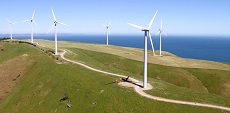
From today’s AFR:
Lyon Solar, Mitsubishi in 1000MW solar battery plunge
In recent days the stated position of the Turnbull government has been to demand that the states wind back to the Turnbull government’s renewable energy targets, which are about 23.5% by 2020 and 26 to 28% by 2030. Federal Labor wants 50% by 2030, as does Queensland. Victoria are aiming for 40% by 2025, SA already had 41% wind. Google Frydenberg warns over pursuit of unrealistic renewable energy targets.
I wrote a post in November 2013 as to what we should do to reconnect politics with climate change reality.
The bottom line is that we need zero net emissions at least by 2030, and that includes emissions from transport agriculture and changes in land use.
I’ve briefly outlined some of the implications for the likely closure of hazelwood at Climate clippings 185, Item 7. Time for the pollies to get serious.
Brian: I think we need to have separate targets for separate sources of emissions and to recognize that doing something for the last 5% may cost a lot lot more than the first 5%. For example, we should be getting on with converting to renewable power because the availability of renewable power is a key part of reducing things like transport emissions.
We also need to recognize that there are a number of strategies that can be used to reduce emissions. These include:
1. Reducing energy demand.
2. Replacing high emission processes with lower emission processes. (Blast furnaces emit more per tonne steel than some alternatives such as combinations of direct reduction with electrical furnaces.)
3. Reducing emissions per unit of energy.
I think we need targets and plans for all these strategies.
1. At the moment I think we need to aim at something like 95% reduction in emissions per kWh for electricity production by 2030 at the latest.
2. Identify what R&D is needed to help reduce some of the other sources of emissions.
3. Identify other decisions that need to be made now so that emission reductions can be made inn the longer term. (Ex: Changes in design and traffic rules for cars.
John, I agree with all of that. Too many “experts” see a price on carbon as a silver bullet.
I’ll import here the action part of the post Climate change: reconnecting politics with reality, not as a blockquote, for easier reading. After the PM making a public satement that the country is going to get serious about climate change, the following should happen, according to Prof John Wiseman:
Then we would need an Australian Climate Solutions Act which set up the targets, the structures and the priority actions. Principal amongst these would be an Australian Climate Solutions Taskforce chaired by the Prime Minister and drawing from state and local governments, business, trade unions and community organisations.
Then we would need six key action plans.
First, an Australian Renewable Energy Plan to achieve 100 per cent renewable energy within 10 years.
Second, an Australian Economic Electrification Plan with initial priorities including a modal shift in passenger and freight transport from road to rail; the rapid replacement of fossil fuel based cars with electric vehicles; and the full electrification of household and industry heating and cooling.
Third, an Australian Energy Efficiency Plan that identifies the regulatory, planning, educational and financial initiatives that could achieve the overall goal of a rapid transition to a zero waste economy.
Fourth, an Australian Sustainable Consumption Strategy.
Fifth, an Australian Sustainable Agriculture and Forestry Plan designed to reduce land-based emissions and increase carbon sequestration.
Finally, state and local governments, community sector and business organisations would collaborate to develop and implement a comprehensive, long-term Australian Climate Change Adaptation and Resilience Plan.
You could no doubt tweak that and add bits, but it covers most of the bases.